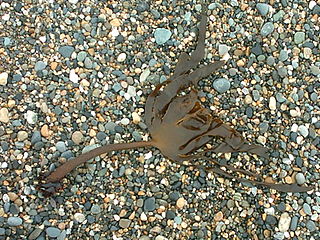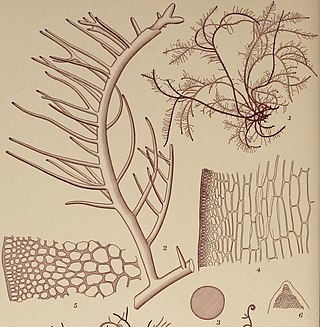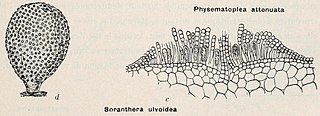
Brown algae, comprising the class Phaeophyceae, are a large group of multicellular algae, including many seaweeds located in colder waters within the Northern Hemisphere. Brown algae are the major seaweeds of the temperate and polar regions. They are dominant on rocky shores throughout cooler areas of the world. Most brown algae live in marine environments, where they play an important role both as food and as a potential habitat. For instance, Macrocystis, a kelp of the order Laminariales, may reach 60 m (200 ft) in length and forms prominent underwater kelp forests. Kelp forests like these contain a high level of biodiversity. Another example is Sargassum, which creates unique floating mats of seaweed in the tropical waters of the Sargasso Sea that serve as the habitats for many species. Many brown algae, such as members of the order Fucales, commonly grow along rocky seashores. Some members of the class, such as kelps, are used by humans as food.

The sea lettuces comprise the genus Ulva, a group of edible green algae that is widely distributed along the coasts of the world's oceans. The type species within the genus Ulva is Ulva lactuca, lactuca being Latin for "lettuce". The genus also includes the species previously classified under the genus Enteromorpha, the former members of which are known under the common name green nori.

Laminaria is a genus of brown seaweed in the order Laminariales (kelp), comprising 31 species native to the north Atlantic and northern Pacific Oceans. This economically important genus is characterized by long, leathery laminae and relatively large size. Some species are called Devil's apron, due to their shape, or sea colander, due to the perforations present on the lamina. Others are referred to as tangle. Laminaria form a habitat for many fish and invertebrates.

Gracilaria is a genus of red algae (Rhodophyta) notable for its economic importance as an agarophyte, as well as its use as a food for humans and various species of shellfish. Various species in the genus are cultivated among Asia, South America, Africa and Oceania.

Leathesia marina (Lyngbye) Decaisne, 1842, previously known as Leathesia difformis Areschoug, 1847, commonly known as the sea cauliflower the sea potato, and brown brains is a species of littoral brown algae in the class Phaeophyceae and the order Ectocarpales, which is commonly attached to other seaweeds and sometimes rocks. When young, the organism is solid but as it matures it becomes hollow and somewhat convoluted and has the appearance of a small leathery brown bag about the same size as a tennis ball. The texture is rubbery and the outer surface smooth.

Saccharina is a genus of 24 species of Phaeophyceae. It is found in the north Atlantic Ocean and the northern Pacific Ocean at depths from 8 m to 30 m.
Rosenvingiella is a genus of green algae in the family Prasiolaceae.

Ecklonia cava, is an edible marine brown alga species found in the ocean off Japan and Korea.

Laurencia is a genus of red algae that grow in temperate and tropical shore areas, in littoral to sublittoral habitats, at depths up to 65 m (213 ft).

Ectocarpus is a genus of filamentous brown alga that is a model organism for the genomics of multicellularity. Among possible model organisms in the brown algae, Ectocarpus was selected for the relatively small size of its mature thallus and the speed with which it completes its life cycle. Tools available for Ectocarpus as a model species include a high quailty genome sequence and both forward and reverse genetic methodologies, the latter based on CRISPR-Cas9.
Ulva conglobata is a species of seaweed in the family Ulvaceae that can be found on Jeju Island of Korea, Qingdao province of China and Yokohama, Japan.

Desmarestia is a genus of brown algae found worldwide. It is also called acid weed, acidweed, oseille de mer, sea sorrel, ウルシグサ, stacheltang, mermaid's hair, landlady's wig, or gruagach. However, 'sea sorrel' can also specifically refer to Desmarestia viridis. Members of this genus can be either annual or perennial. Annual members of this genus store sulfuric acid in intracellular vacuoles. When exposed to air they release the acid, thereby destroying themselves and nearby seaweeds in the process. They are found in shallow intertidal zones.

Ralfsiaceae is a family of brown algae in the order Ralfsiales.

Hypnea is a genus of red algae, and a well known carrageenophyte.

Soranthera ulvoidea, sometimes called the studded sea balloon, is a species of brown algae in the family Chordariaceae. It is the only species in the monotypic genus Soranthera. The generic name Soranthera is from the Greek soros (heap) and antheros (blooming). The specific epithet ulvoidea refers to certain resemblances the algae has with Ulva. The name in Japanese is 千島袋のり / ちしまふろくのり literally meaning "Kuril Islands bag nori".

Dictyota is a genus of brown seaweed in the family Dictyotaceae. Species are predominantly found in tropical and subtropical seas, and are known to contain numerous chemicals (diterpenes) which have potential medicinal value. As at the end of 2017, some 237 different diterpenes had been identified from across the genus.
Nathaniel Lyon Gardner, was an American phycologist and mycologist who taught at the University of California, Berkeley, where he was the curator of the University Herbarium. He is known for his work on seaweeds of the Pacific Coast, as well as on freshwater algae and fungi, and among his publications is the important reference work Algae of Northwestern America.
Saccharina dentigera is a species of brown algae, in the family Laminariaceae. It is native to shallow water in the northeastern Pacific Ocean from the Gulf of Alaska to Baja California.

Acinetosporaceae is a family of brown algae in the order Ectocarpales.
Fucophycidae is a subclass of Phaeophyceae which contains the most complex and evolved orders of Chromista algae. The members of this subclass have stalks with several morphological forms and distinct structures, characterized by an intercalary growth and a basic heteromorphic, sometimes secondarily iso- or sub-isomorphic life cycle.















